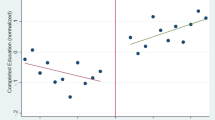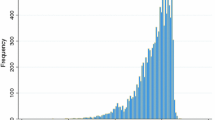Abstract
Using pooled data from the 1980, 1985, and 1990 Current Population Surveys, we describe fertility trends by age and education for the period 1963–1989. Interest focuses on whether the effects of education have changed across this period. We show that women with college degrees experienced dramatic shifts toward later ages of childbearing. This shift is consistent with arguments we develop about the increased opportunity for women to pursue careers and about changes in the availability of child care
Similar content being viewed by others
References
Bean, F.D. and M. Tienda. 1987. The Hispanic Population of the United States. New York: Russell Sage.
Bianchi, S.M. and D. Spain. 1986. American Women in Transition. New York: Russell Sage.
Blake, J. 1972. “Coercive Pronatalism and American Population Policy.” Pp. 81–109 in Aspects of Population Growth, edited by R. Parke and C.F. Westoff. Washington, DC: U.S. Government Printing Office.
Blau, F. and M.A. Ferber. 1986. The Economics of Women, Men and Work. Englewood Cliffs, NJ: Prentice-Hall.
Bumpass, L.L. 1973. “Is Low Fertility Here to Stay?” Family Planning Perspectives 5:67–69.
Bumpass, L.L, J.A. Sweet, and A.J. Cherlin. 1991. “The Role of Cohabitation in Declining Rates of Marriage.” Journal of Marriage and the Family 53:913–27.
Bumpass, L.L. and J.A. Sweet. 1989. “National Estimates of Cohabitation.” Demography 26:615–25.
Chen, R. and S.P. Morgan. 1991. “Recent Trends in the Timing of First Births in the United States.” Demography 28:513–33.
Cheriin, A.J. 1992. Marriage, Divorce and Remarriage. Cambridge, MA: Harvard University Press.
Davis, K. and P. van den Oever. 1982. “Demographic Foundations of New Sex Roles.” Population and Development Review 8:495–511.
England, P. and G. Farkas. 1986. Households, Employment and Gender: A Social, Economic and Demographic View. New York: Aldine.
Goldin, C. 1992. “The Meaning of College in the Lives of American Women: The Past One-Hundred Years.” Working Paper 4099, National Bureau of Economic Research. Cambridge, MA: National Bureau of Economic Research.
Hochschild, A. 1989. The Second Shift. New York: Avon.
Jacobs, J. 1989. Revolving Doors. Stanford, CA: Stanford University Press.
Jacobsen, J.P. 1994. The Economics of Gender. Cambridge, MA: Blackwell.
Johansen, A.S., A. Leibowitz, and L.J. Waite. 1994. “Parents’ Demand for Child Care.” Working Paper 94-13, RAND Labor and Population. Santa Monica: RAND.
Karoly, L.A. 1996. “Anatomy of the U.S. Income Distribution Two Decades of Change.” Oxford Review of Economic Policy 12:7796.
Lewis, C. and S. Ventura. 1990. “Birth and Fertility Rates by Education: 1980 and 1985.” Vital and Health Statistics 21(49), Hyattsville, MD: National Center for Health Statistics.
Mare, R. 1995a. “Demography and the Evolution of Educational Inequality.” CDE Working Paper 95-10. Madison: Center for Demography and Ecology, University of Wisconsin.
— 1995b. “Changes in Educational Attainment and School Enrollment.” Pp. 155–213 in The State of the Union: America in the I990s, edited by R. Farley. New York: Russell Sage Foundation.
Mare, R.D. and M. Tzeng. 1989. “Fathers’ Ages and the Social Stratification of Sons.” American Journal of Sociology 95: 108–31.
Marini, M.M. 1978. “The Transition to Adulthood: Sex Differences in Educational Attainment and Age at Marriage.“ American Sociological Review 43:483–507.
Monnier, A. and C. de Guibert-Lantoine. 1993. “The Demographic Situation of Europe and the Developed Countries Overseas: An Annual Report.” Population: An English Selection 5:249–72.
Morgan, S.P. 1991. “Late Nineteenth and Early Twentieth Century Childlessness in the United States.” American Journal of Sociology 97:779–807.
Morgan, S. P. Forthcoming. “Characteristic Features of Modem American Fertility: A Description of Late Twentieth Century U.S. Fer-tility Trends and Differentials.” Population and Development Review (Supplement).
Morgan, S.P., N. Botev, R. Chen, and J. Huang. 1994. “White and Nonwhite Trends in Fertility Timing: Comparisons Using Vital Registration and Current Population Surveys.” Presented at the annual meetings of the Population Association of America, Miami.
Oppenheimer, Y.K. 1994. “Women’s Rising Employment and the Future of the Family in Industrial Societies.” Population and Development Review 20:293–342.
Pagnini, D.L. and R.R. Rindfuss. 1993. “The Divorce of Marriage and Childbearing: Changing Attitudes and Behavior in the United States.” Population and Development Review 19:331–48.
Parnell, A.M., G. Swicegood, and G. Stevens. 1994. “Nonmarital Pregnancies and Marriage in the United States.” Social Forces 73:263–87.
Raftery, A.E. 1986. “Choosing Models for Cross-Classifications.” America Sociological Review 51: 145–46.
— 1995. “Bayesian Model Selection in Social Research.” Sociological Methodology 25: 111–63.
Reskin, B. and P. Roos. 1990. Job Queues, Gender Queues: Explaining Womens Inroads into Male Occupations. Philadelphia: Temple University Press.
Rindfuss, R.R. 1991. “The Young Adult Years: Diversity, Structural Change and Fertility.” Demography 28:493–513.
Rindfuss, R.R., K.L. Brewster, and A.A. Kavee. 1994. “Women, Work, and Children: Behavioral and Ideational Change in the United States.” Presented at the International Union of the Scientific Study of Population Conference: “Seminar on Values and Fertility Change,” Sion, Switzerland.
Rindfuss, R.R., L.L. Bumpass, and C. St. John. 1980. “Education and Fertility: Implications for the Roles Women Occupy.” American Sociological Review 45:431–47.
Rindfuss, R.R., S.P. Morgan, and G. Swicegood. 1988. First Births in America. Berkeley: University of California Press.
Rindfuss, R.R. and A. Parnell. 1989. “The Varying Connection Between Marital Status and Childbearing in the United States.” Population and Development Review 15:447–70.
Rindfuss, R.R. and J.A. Sweet. 1977. Postwar Fertility Trends and Differentials in the United States. New York: Academic Press.
Rindfuss, R.R. and A. van den Heuvel, 1990. “Cohabitation: A Precursor to Marriage or an Alternative to Being Single?” Population and Development Review 16:703–26.
Rosenfeld, R.A. 1994. “Women’s Work Histories.” Prepared for the workshop “Expanding Frameworks for Fertility Research in Industrialized Countries,” Woods Hole, MA.
Ryder, N.B. 1973. “Recent Trends and Group Differences in Fertility.” Pp. 57–68 in Toward the End of Growth: Population in America. Englewood Cliffs, NJ: Prentice-Hall.
Smith, H.L., S.P. Morgan, and T. Koropeckyj-Cox. 1996. “A Decomposition of Trends in the Nonmarital Fertility Ratios of Blacks and Whites in the United States, 1960-1992.” Demography 33:141–51.
Swicegood, C.G., S.P. Morgan, and R.R. Rindfuss. 1984. “Measurement and Replication: Evaluating the Consistency of Eight U.S. Fertility Surveys.” Demography 21:19–33.
Thornton, A. 1989. “Changing Attitudes Toward Family Issues in the United States.” Journal of Marriage and the Family 51:873–93.
Upchurch, D.M., J. McCarthy, and L.R. Ferguson. 1993. “Childbearing and Schooling: Disentangling Temporal and Causal Mechanisms.” American Sociological Review 58:738–40.
U.S. Bureau of the Census. 1982. Trends in Childcare Arrangements of Working Mothers. Current Population Reports, Series P-23, No. 117. Washington, DC: U.S. Government Printing Office.
—. 1992a. Statistical Abstract of the United States: 1992. Washington, DC: U.S. Government Printing Office.
—. 1992b. Who s Minding the Kids? Childcare Arrangements: Fall 1988. Current Population Reports, Series P-70, No. 30. Washington, DC: U.S. Government Printing Office.
—. 1992c. Educational Attainment in the U.S., March 1991 and 1992. Current Population Reports, Series P-20, No. 462. Washington, DC: U.S. Government Printing Office.
Westoff, C.F. 1978. “Marriage and Fertility in Developed Countries.” Scientific American 239:51–57.
Wilkie, J.R. 1981. “The Trend Toward Delayed Parenthood.“ Journal of Marriage and the Family 43:583–91.
Author information
Authors and Affiliations
Corresponding author
Additional information
This research was supported by NICHD Grant ROI-HD-29582. Thanks to Tim Cheney for programming assistance, and to Deanna Pagnini and three Demography reviewers for useful comments on earlier drafts.
Rights and permissions
About this article
Cite this article
Rindfuss, R.R., Morgan, S.P. & Offutt, K. Education and the changing age pattern of American fertility: 1963–1989. Demography 33, 277–290 (1996). https://doi.org/10.2307/2061761
Issue Date:
DOI: https://doi.org/10.2307/2061761




